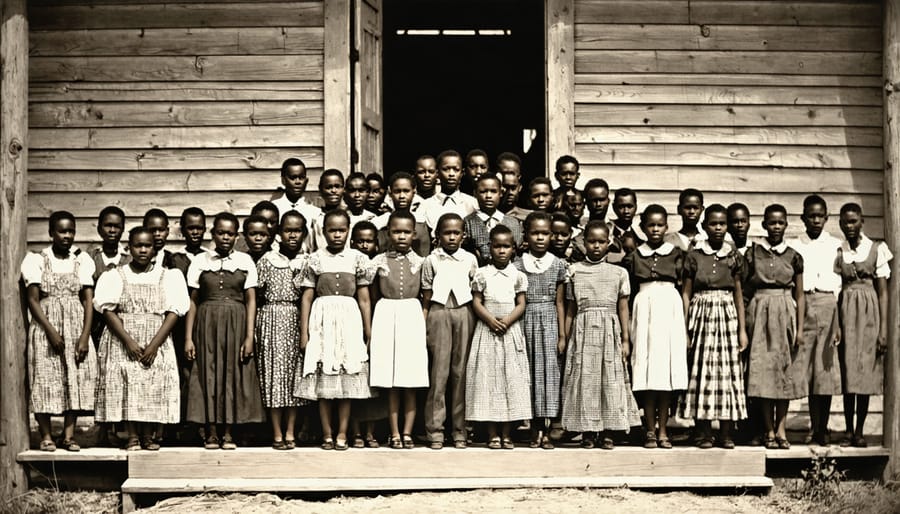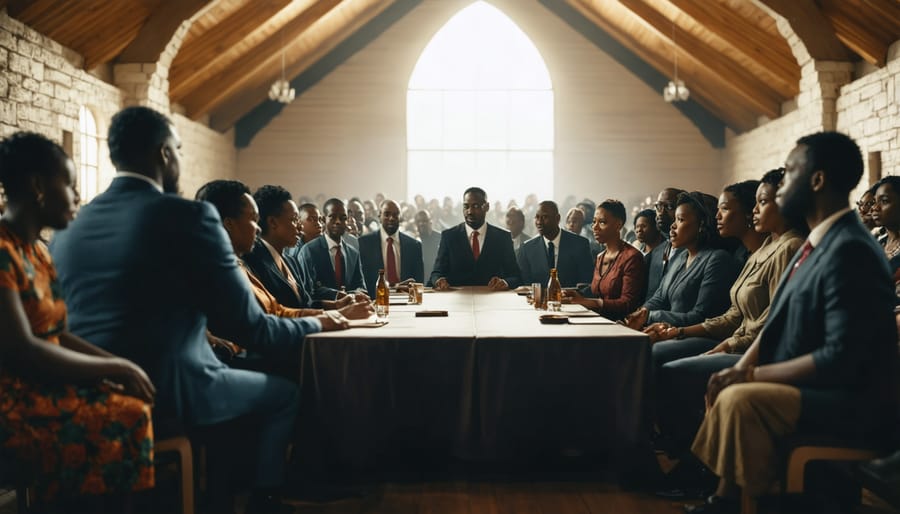The Black church stands as one of the most transformative institutions in African American history, serving as both sanctuary and catalyst for social change within free Black communities. From the wooden pews of humble meetinghouses to the grand pulpits of urban congregations, these sacred spaces became the heartbeat of Black liberation, education, and community empowerment. Throughout the 18th and 19th centuries, churches provided more than spiritual nourishment; they became the first schools for freed slaves, safe havens for political organizing, and vital centers for mutual aid and economic cooperation. Leaders like Richard Allen and Absalom Jones established independent Black churches that demonstrated self-determination and resistance against racial oppression, while simultaneously nurturing faith, dignity, and hope. This profound influence continues to echo through generations, as the Black church remains a cornerstone of community strength, cultural preservation, and social justice advocacy. Understanding this rich legacy illuminates not just the historical significance of these institutions, but their enduring role in shaping Black identity and advancement in America.
The Church as a Spiritual Haven
Finding Strength Through Faith
Biblical teachings served as a powerful source of strength and resilience for the free Black community during challenging times. Through scripture, they found messages of hope, dignity, and divine worth that countered the degrading narratives of slavery and discrimination. The Bible’s stories of liberation, particularly the Exodus narrative of Moses leading the Israelites to freedom, resonated deeply and provided a framework for understanding their own struggles and aspirations.
Passages emphasizing equality before God, such as Galatians 3:28 – “There is neither Jew nor Greek, slave nor free, male nor female, for you are all one in Christ Jesus” – offered spiritual validation of their inherent human dignity. The prophetic traditions of speaking truth to power and seeking justice inspired many to become vocal advocates for abolition and civil rights, as explored in articles on Racial Reconciliation Through the Gospel.
Moreover, congregational worship provided opportunities to experience spiritual freedom and express emotions through prayer, song, and testimony. This spiritual empowerment through faith helped forge strong community bonds and instilled a sense of divine purpose that sustained them through persecution and hardship, while nurturing hope for a better future.
Creating Sacred Spaces
In the face of oppression and segregation, Black churches emerged as powerful sanctuaries where free Black communities could worship, gather, and express themselves without restriction. These sacred spaces became more than just houses of worship; they transformed into vital community centers where African Americans could freely celebrate their faith, culture, and identity.
The church buildings themselves held deep symbolic meaning, representing both spiritual refuge and physical safety. Many were constructed through the collective efforts of congregants who pooled their resources and labor, creating a powerful sense of ownership and pride. These structures stood as testaments to the resilience and determination of free Black communities.
Within these hallowed walls, worshippers found solace in spiritual practices that blended African traditions with Christian teachings. The vibrant services, filled with spirited singing, passionate preaching, and communal prayer, provided emotional and spiritual healing. Church gatherings offered opportunities for fellowship, celebration, and mutual support, creating bonds that strengthened the entire community.
These sacred spaces also served as meeting places where people could discuss community concerns, plan social initiatives, and organize for positive change, all while remaining rooted in their faith and values.

Education and Empowerment
Sunday Schools and Bible Study
Sunday Schools and Bible study sessions became powerful vehicles for education within the free Black community, serving a dual purpose of spiritual growth and literacy development. These gatherings provided a safe, structured environment where both children and adults could learn to read using the Bible as their primary text. The practice of reading scripture not only strengthened their faith but also equipped them with essential reading skills that were often denied through traditional educational channels.
Church leaders recognized that Biblical literacy was inseparable from general literacy, and they skillfully wove both into their religious instruction. Many free Black churches established formal Sunday School programs that incorporated basic reading and writing lessons alongside Bible stories and religious teachings. These programs often extended beyond Sunday meetings, with weekly Bible study groups providing additional opportunities for educational advancement.
The impact was transformative, as these educational initiatives empowered community members to read not only religious texts but also newspapers, legal documents, and other important materials. This religious-based education became a foundation for broader learning and personal development, creating pathways to greater independence and community leadership.

Leadership Development
The church played a pivotal role in nurturing leaders who would become powerful voices for justice and community advancement. Through mentorship programs and practical application of biblical leadership principles, churches provided a sacred space where individuals could develop their leadership skills while staying grounded in faith.
Many prominent civil rights leaders, including ministers and activists, emerged from church communities where they first learned to speak, organize, and advocate for their people. The church’s organizational structure offered opportunities for members to serve in various leadership positions, from Sunday school teachers to deacons and trustees, helping them build confidence and administrative skills.
These leadership development initiatives went beyond religious duties, preparing individuals to advocate for educational opportunities, economic empowerment, and social justice. Church leaders often served as bridges between their communities and the broader society, negotiating for better conditions and representing their congregations’ interests in civic matters.
The church’s emphasis on servant leadership, inspired by Christ’s example, created generations of leaders who understood that true leadership meant serving others and working for the collective good of the community.
Social Support and Community Building
Mutual Aid Societies
Black churches played a pivotal role in establishing mutual aid societies, demonstrating remarkable examples of faith-driven community transformation through organized support systems. These societies functioned as essential safety nets, providing financial assistance, healthcare, and burial services to community members who were often excluded from mainstream institutions.
Church-based mutual aid societies pooled resources from congregation members to assist families during times of illness, unemployment, or bereavement. They operated on Christian principles of brotherhood and sisterhood, creating sustainable support networks that strengthened community bonds. Members would contribute small amounts regularly, ensuring that help was available when needed.
These societies also established widow and orphan funds, educational scholarship programs, and emergency assistance initiatives. The church’s leadership often managed these programs, ensuring transparent distribution of resources while maintaining dignity and respect for recipients. This system of mutual support became a cornerstone of Black community resilience, exemplifying how faith communities could work together to meet both spiritual and practical needs of their members.
Cultural Preservation
The Black church served as a vital sanctuary for preserving and celebrating African American cultural heritage, creating a space where traditions could flourish despite societal pressures. Through spirituals, gospel music, and distinctive worship styles, churches maintained connections to African musical and oral traditions while adapting them to express Christian faith. These cultural expressions became powerful tools for both worship and racial reconciliation in the church, bridging generational gaps and strengthening community bonds.
Church gatherings incorporated traditional African customs into religious celebrations, from call-and-response worship to the sharing of communal meals. These practices helped preserve cultural identity while creating new traditions that reflected the unique experiences of free Black Americans. The church also became a repository for oral histories, with elders passing down stories of faith, resilience, and triumph to younger generations through testimonies and spiritual teachings.
Additionally, church celebrations like Watch Night services and special programs during holidays became cultural touchstones that reinforced community values while honoring both African heritage and Christian faith. These traditions continue to influence modern worship practices, demonstrating the enduring impact of early Black churches on American Christian culture.
Political Advocacy and Civil Rights
Safe Spaces for Activism
The Black church served as more than just a house of worship; it became a sanctuary for civil rights activism and social justice discussions. These sacred spaces provided a safe haven where free Black communities could gather without fear of persecution to address pressing social issues and organize for change. Church basements and meeting rooms became vital centers for planning peaceful protests, voter registration drives, and community improvement initiatives.
During the antebellum period and continuing through the Civil Rights Movement, churches offered protected spaces where leaders could speak freely about equality and justice. The spiritual authority of the church helped shield these gatherings from interference, while its respected position in society provided legitimacy to the movement’s activities.
These gathering spaces fostered unity and strength within the community, allowing members to share experiences, develop strategies, and support one another in their pursuit of justice. The church’s role as a safe space exemplified Christ’s teaching about standing with the oppressed and seeking justice for all God’s children. This legacy continues today, as many churches remain centers for community organizing and social justice advocacy.

Prophetic Voice
Church leaders within the Black community consistently raised their voices against societal injustice, serving as powerful advocates for equality and human dignity. From the pulpit, pastors boldly addressed issues of discrimination, segregation, and racial violence, drawing strength from biblical teachings about justice and human worth. These prophetic voices reminded their congregations that all people are created in God’s image and deserve equal treatment under both divine and human law.
Ministers often used scriptures like Amos 5:24, “Let justice roll down like waters, and righteousness like an ever-flowing stream,” to inspire their communities to stand firm in the face of oppression. They not only preached about justice but also organized peaceful protests, wrote letters to politicians, and mobilized their congregations to take action against discriminatory practices.
The church’s prophetic role extended beyond addressing racial inequality to encompass economic justice, educational access, and political rights. Leaders emphasized both spiritual salvation and social transformation, understanding that their calling included speaking truth to power while offering hope and encouragement to their communities.
The church’s profound impact on free Black communities continues to resonate through generations, serving as both a testament to faith and a blueprint for community empowerment. Today’s Black churches carry forward this sacred legacy, maintaining their role as spiritual sanctuaries while adapting to meet contemporary challenges. They remain vital centers of hope, healing, and social justice, providing everything from youth mentorship programs to senior care services.
The historical foundation laid by early Black churches demonstrates the enduring power of faith-based community building. Modern congregations draw inspiration from this heritage as they address current issues like educational inequality, healthcare access, and economic development. Through worship services, outreach programs, and advocacy efforts, these churches continue to nurture both spiritual growth and social progress.
As we look to the future, the Black church stands as a living reminder of God’s faithfulness and the strength found in united communities. Its ongoing ministry exemplifies Galatians 6:2, “Bear one another’s burdens, and so fulfill the law of Christ,” offering a model of Christian service that uplifts, empowers, and transforms lives across generations.
